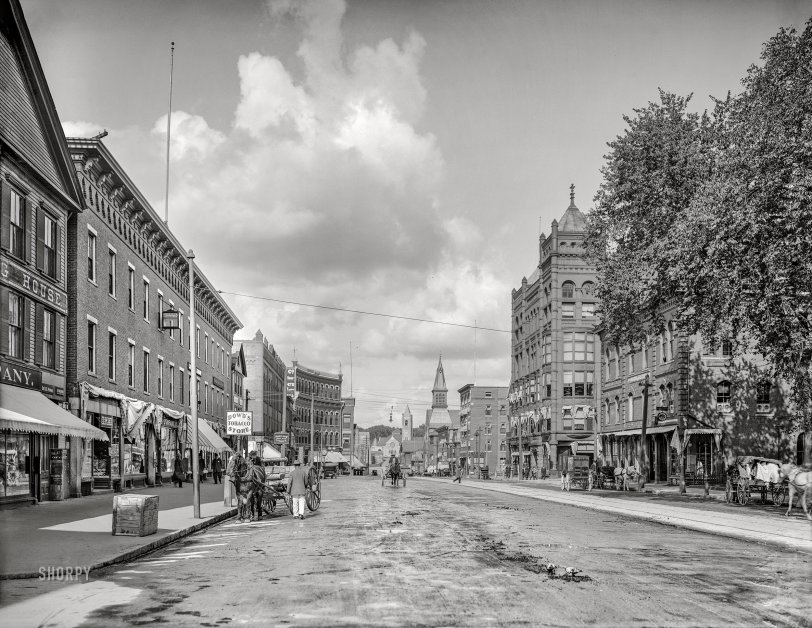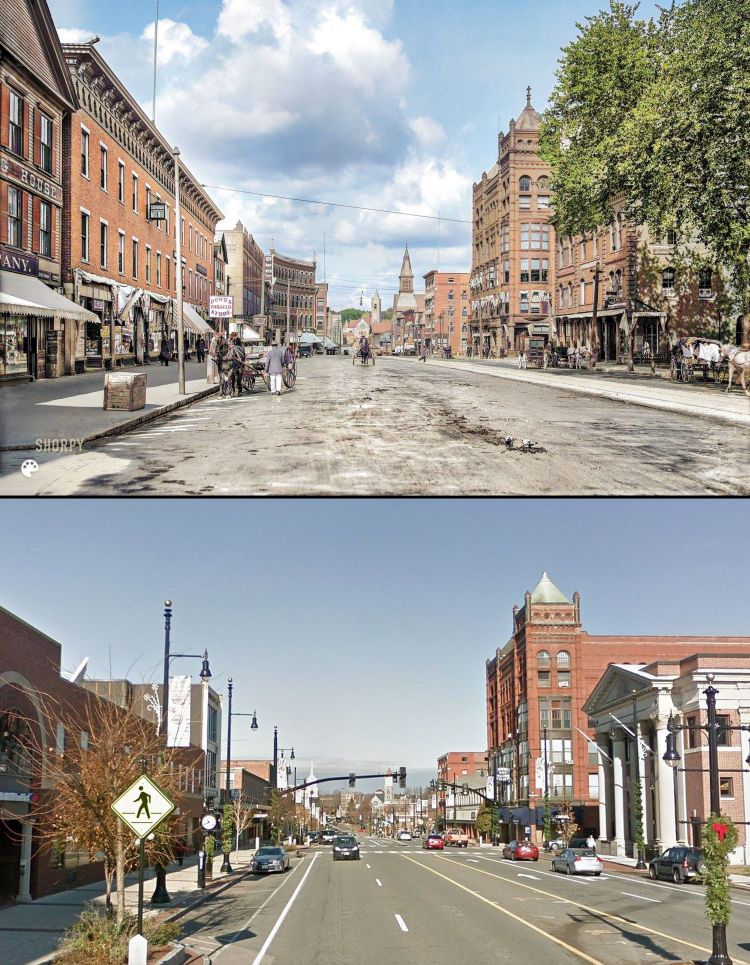


Framed or unframed, desk size to sofa size, printed by us in Arizona and Alabama since 2007. Explore now.
Shorpy is funded by you. Patreon contributors get an ad-free experience.
Learn more.

- What a headache!
- Baldwin 62303
- Baldwin VO-1000
- Cold
- No expense spared
- Tough Guys
- Lost in Toyland
- And without gloves
- If I were a blindfolded time traveler
- Smoke Consumer Also Cooks
- Oh that stove!
- Possibly still there?
- What?!?
- $100 Reward
- Freeze Frame
- Texas Flyer wanted
- Just a Year Too Soon
- WWII -- Replacing men with women at the railroad crossing.
- Yes, Icing
- You kids drive me nuts!
- NOT An Easy Job
- I wonder
- Just add window boxes
- Icing Platform?
- Indiana Harbor Belt abides
- Freezing haze
- Corrections (for those who care)
- C&NW at Nelson
- Fallen Flags
- A dangerous job made worse
Print Emporium
Nashua: 1908

1908. "Main Street -- Nashua, New Hampshire." At right, offices of the Nashua Telegraph and Fletcher's Optical Parlors. 8x10 inch glass negative, Detroit Publishing Company. View full size.
Tea Time
The Grand Union Tea Company delivery wagon in the Nashua photo made me curious. My local New Hampshire grocery store used to be a Grand Union. I found a brief history of the company here:
https://oldmainartifacts.wordpress.com/2013/10/07/grand-union-tea-compan...
Different process = CLOUDS!
Eary photographic processes were primarily sensitive to only blue light. Numerous newer processes throughout the late 19th century added increases sensitivity into the greens and yellows resulting in what we now call orthochromatic materials.
It wasn't until around 1906 that a truly panchromatic emulsion with full sensitivity to red was developed. This took several decades to become dominant. It wasn't until the panchromatic films and plates became available that we begin to see photos that can render skies anything other than nearly blank white.
Orthochromatic materials remained in use for quite a while largely because you could develop them under a red safelight. Panchromatic materials required total darkness.
[Here and here, some clouds from 1864! - Dave]
Light grey/white clouds against a blue sky require a panchromatic emulsion, otherwise the clouds and sky reproduce nearly the same light grey. Only when the clouds are all grey and dark grey (think: storm clouds) will they reproduce on earlier orthchromatic or pure blue sensitive emulsions.
Straight and true
I lived in Nashua for 12 wonderful years and lived in the North End right off of Concord. This image did raise a question about the curved building a block from the river crossing. Any straightening alluded to earlier would have taken place much earlier in the 19th century...
The Sanborn Insurance maps of 1912 indicate that Main Street and the bridge were already where they are today. But the curved building, identified as the Howard Block gracefully curved to widen the main street from the width of the bridge (I am guessing). Main Street really is three lanes wide in each direction... feels like an avenue in Manhattan. I am also grateful that the Library of Congress has these Sanborn maps...! Terrific detail about buildings and their particular use.
Here is the link to that image: https://www.loc.gov/resource/g3744nm.g3744nm_g053631912/?sp=32&r=0.517,0...
Because now you can bank online
Working left-to-right:
JennyPennifer's comment caused me to pay special attention to the police officer walking his beat, just to the left of the wagon parked at the curb. He's dressed like a London Bobby.
The four-story building with the curved front is, regrettably, gone. This likely happened when Main Street was straightened, and a newer bridge was built across the Nashua River. The Romanesque church at the end of the street is on the other side of the river.
The building at right, which became a bank in jrpollo's update, is now luxury condos, called The Mint. Not to criticize too much, but my first efficiency apartment had more kitchen space. I guess the residents are expected to eat out. A number of nearby restaurants have expanded their al fresco option to include both the sidewalk and the parallel parking spaces in front of their restaurant.
CLOUDS!
I don't know if it was luck or some type of different exposure process, but it's rare to see a sky with clouds in these old photos. The cameras couldn't pick up the subtle shades and usually the skies appear completely white even though at the time they may have been overcast or partly cloudy.
Safe space
Maybe you heard this already but WalletHub just named Nashua, New Hampshire, the safest city in America. The other nine in the top ten are Columbia, Maryland; South Burlington, Vermont; Gilbert, Arizona; Warwick, Rhode Island; Portland, Maine; Casper, Wyoming; Yonkers, New York; Burlington, Vermont; and Scottsdale, Arizona.
According to the same study, South Burlington, Vermont (the third safest city), "also tied with Cleveland and Cincinnati, Salem, Oregon, Washington, D.C. and Seattle for the most hate crimes per capita." Uh oh. Maybe move to Burlington, Vermont -- less than three miles away and coming in at ninth on the safest city list.
Or just stay put and take your chances.
Pigeons
Just try to tell me pigeons aren't trash birds!

























On Shorpy:
Today’s Top 5